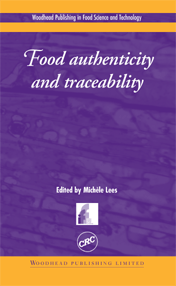Food Authenticity and Traceability
Dr Michele Lees is Director of Collaborative Research at Eurofins Scientific Laboratories, internationally known for its work on food analysis and authentication.
The ability to trace and authenticate a food product is of major concern to the food industry. This important topic is reviewed extensively in Food Authenticity and Traceability. The first part of the book deals with analytical techniques applied to food authentication, with chapters on both established and developing technologies, and discussions of chemometrics and data handling. Part 2 relates these methodologies to particular food and beverage products, such as meat, dairy products, cereals, and wine. The final section reviews traceability in detail, examining the development of efficient traceability systems and their application in practice to animal feed and fish processing.
下载地址:
Download
Mirror

Contents
Part 1: Methods for authentication and traceability
Part 2: Authenticating and tracing particular foods
Part 3: Traceability
Introduction
Part 1: Methods for authentication and traceability
Advanced PCR techniques in identifying food components
N Marmiroli, University of Parma, Italy
- Introduction
- Qualitative and quantitative PCR techniques
- Method validation
- Advanced PCR techniques
- Applying PCR techniques: identifying genetically-modified organisms in food
- Applying PCR techniques: molecular markers and identification of cultivar or breed
- Future trends: PCR and identity preservation of foods
- References
DNA methods for identifying plant and animal species in food
J Lenstra, University of Utrecht, The Netherlands
- Introduction
- Meat species identification
- Identifying species in dairy products, feedstuffs and fish
- Identifying plant species, cell lines and animal breeds
- Comparison and validation of methods
- Future trends
- References
Enzyme immunoassays for identifying animal species in food
E Maertlebauer, University of Munich, Germany
- Introduction
- Principles of enzyme immunoassays
- Applications: identifying animal species in meat, dairy and other foods
- Advantages and disadvantages
- Sources of further information and advice
- References
Proteome and metabolome analyses for food authentication
S Vaidyanathan and R Goodacre, University of Manchester Institute of Science and Technology (UMIST), UK
- Introduction
- The importance of proteomics and metabolomics
- Proteome analysis
- Metabolome analysis
- Fingerprinting techniques
- Applications: rapid authentication of food components
- Future trends
- Sources of further information and advice
- References
Near infra-red absorption technology for analysing food composition
I Benson, NDC Infrared Engineering, UK
- Introduction
- Principles of measurement
- Instrumentation
- Multi-component analysis of food products
- Advantages and disadvantages
- On-line applications
- Future trends
- References
NMR spectroscopy in food authentication
G Le Gall and I Colquhoun, Institute of Food Research, UK
- Introduction
- Using NMR spectroscopy: sample preparation
- Data recording and processing
- Signal assignment and chemometrics
- Advantages and disadvantages of the NMR technique
- Applications: authenticating oils, beverages, animal and other foods
- Future trends
- Sources of further information and advice
- References
Using stable isotope ration mass spectrometry (IRMS) in food authentication and traceability
S Kelly, University of East Anglia, UK
- Introduction: stable isotopes
- Principles of operation of IRMS
- Current applications: adulteration of fruit juice, honey and wine
- New applications: determining the geographical origin of foods
- Future trends: position-specific isotope analysis
- Conclusion
- References and further reading
Spectrophotometric techniques
M Meurens, Universite Catholique de Louvain, Belgium
- Introduction
- Ultraviolet spectroscopy: detecting fruit and vegetable oil adulteration
- Infrared spectroscopy for food authentication
- Fluorescence spectroscopy for food authentication
- Raman spectroscopy for food authentication
- Conclusion
- References
Gas chromatography
E Forgacs and T Cserhati, Hungarian Academy of Sciences
- Introduction
- Principles and technologies
- Sample preparation
- Applications: identifying flavour compounds
- Advantages and disadvantages of gas chromatography
- References
High pressure liquid chromatography (HPLC) in food authentication
L Nollet, Hogeschool Gent, Belgium
- Introduction: principles and technologies
- Authenticating fruit products
- Authenticating oils
- Authenticating other foods
- Future trends
- References
Enzymatic techniques for authenticating food components
G Henninger, University of Applied Sciences – Lemgo, Germany
- Introduction
- Analysing enzymes in sugars, acids, salts, alcohols and other compounds
- Sample materials and equipment
- Sample preparation
- Performing an assay
- Routine enzymatic methods for food analysis and authentication
- Advantages and disadvantages
- Future trends
- Acronyms
- References and further reading
In-line sensors for food analysis
P Patel and C Beveridge, Leatherhead Food International Ltd, UK
- Introduction
- Requirements for in-line sensors
- Current commercial sensor systems
- In-line sampling
- Future trends
- Sources of further information and advice
- References
Chemometrics in data analysis
R Leardi, University of Genoa, Italy
- Introduction
- Data collection and display
- Classification
- Modelling
- Calibration
- Variable selection
- Future trends
- Conclusion: the advantages and disadvantages of chemometrics
- Sources of further information and advice
- References
Part 2: Authenticating and tracing particular foods
Species identification in processed seafoods
C Sotelo and R Perez-Martin, Instituto de Investigaciones Marinas, Spain
- Introduction: the importance of species identification
- The problem of species identification in seafood products
- The use of biomolecules as species markers
- The use of DNA for species identification
- Polymerase chain reaction (PCR) techniques
- Methods not requiring a previous knowledge of the sequence
- Methods using sequence information
- Future trends
- Sources of further information and advice
- References
Meat and meat products
M Lees, Eurofins Scientific, France
- Introduction: key authenticity issues
- Species identification
- Adulteration issues
- References
Milk and dairy products
F Ulberth, University of Agricultural Sciences, Austria
- Introduction: authenticity issues for milk and dairy products
- Detection and quantification of foreign fats
- Identifying milk of different species
- Other authenticity and traceability indices
- Conclusions
- References
Cereals
G Downey, TEAGASC – The National Food Centre, Ireland
- Introduction
- Wheat
- Pasta
- Rice
- References
Herbs and spices
R Singhal and P Kulkarni, Institute of Chemical Technology – Mumbai, India
- Introduction: quality and adulteration issues
- Whole spices and spice powders
- Essential oils
- Oleoresins
- Testing for sensory quality and geographical origin
- Sources of further information and advice
- References
Identifying genetically-modified organisms (GMOs)
B Popping, Eurofins Scientific, France
- Introduction
- Characteristics of transgenic crops
- Labelling requirements
- Detection methods and traceability systems for GMOs
- Future trends
- References
Wine authenticity
I Arvanitoyannis, University of Thessaly, Greece
- Introduction: traditional and novel methods for testing wine authenticity
- Analysis of minerals and trans-resveratol
- Analysis of phenols, volatiles and amino acids
- The use of NMR, FT-IR and sensory techniques
- Data analysis
- Conclusions
- References
Part 3: Traceability
Traceability in food processing: an introduction
C Morrison, Youngs Bluecrest Seafoods Ltd, UK
- Introduction: the key objectives of traceability
- Traceability coding
- Components of traceability systems
- Using traceability systems when problems arise
- Summary
- References
Developing traceability systems across the supply chain
A Furness and K Osman, Centre for Automatic Identification and Intelligent Systems – Birmingham, UK
- Introduction
- Accommodating multi-functional traceability requirements
- Item-specific data capture
- The EANUCC coding system
- Data carrier technologies
- Linking item-attendant data and database information
- The FOODTRACE project
- Conclusions
Developing and implementing an effective traceability and product recall system
M Dillon and M Thomson, Grimsby Institute of Food and Fisheries, UK
- Introduction Building traceability in the supply chain: an example
- Building traceability in the supply chain: an example
- Key elements in a traceability system
- Verifying control
- Conclusions
- Sources of further information and advice
- References and further reading
Traceability in fish processing
E Larsen, Danish Institute of Fisheries Research
- Introduction: the fish processing industry
- Traceability requirements
- Current traceability systems
- Improving traceability systems
- Traceability issues in aquaculture
- Attitudes to traceability
- References
Safety and traceability of animal feed
S Notermans and H Beumer, TNO Nutrition and Food Research, The Netherlands
- Introduction
- Requirements for safe feed production
- Risks from animal feed
- Control systems to manage risks: GMP and HACCP
- The role and requirements of traceability systems
- Future trends: hazard early warning systems
- References
- Abbreviations
Geographical traceability of cheese
L Pillonel and J Bosset, Federal Dairy Research Station of Liebefeld, Switzerland
- Introduction
- Approaches to identifying geographical origin
- Analytical methods: primary indicators
- Analytical methods: secondary indicators
- Conclusion
- References
Advanced DNA-based detection techniques for genetically-modified food
A Holst-Jensen, National Veterinary Institute, Norway
- Introduction
- Issues in detecting genetically-modified organisms (GMOs)
- Developing improved GMO detection methods
- Future trends in detecting GMOs in food
- References
 david_lxl
发布于2007-04-28 13:48:15
david_lxl
发布于2007-04-28 13:48:15



 江南游子
发布于2007-04-28 13:59:24
江南游子
发布于2007-04-28 13:59:24

 david_lxl
发布于2007-04-28 17:57:00
david_lxl
发布于2007-04-28 17:57:00
 江南游子
发布于2007-04-28 18:32:00
江南游子
发布于2007-04-28 18:32:00


 新建文件夹.part1.rar
新建文件夹.part1.rar 新建文件夹.part2.rar
新建文件夹.part2.rar 新建文件夹.part3.rar
新建文件夹.part3.rar 新建文件夹.part4.rar
新建文件夹.part4.rar david_lxl
发布于2007-04-29 12:33:31
david_lxl
发布于2007-04-29 12:33:31



 wenjingli123发布于2007-12-18 18:54:53
wenjingli123发布于2007-12-18 18:54:53

